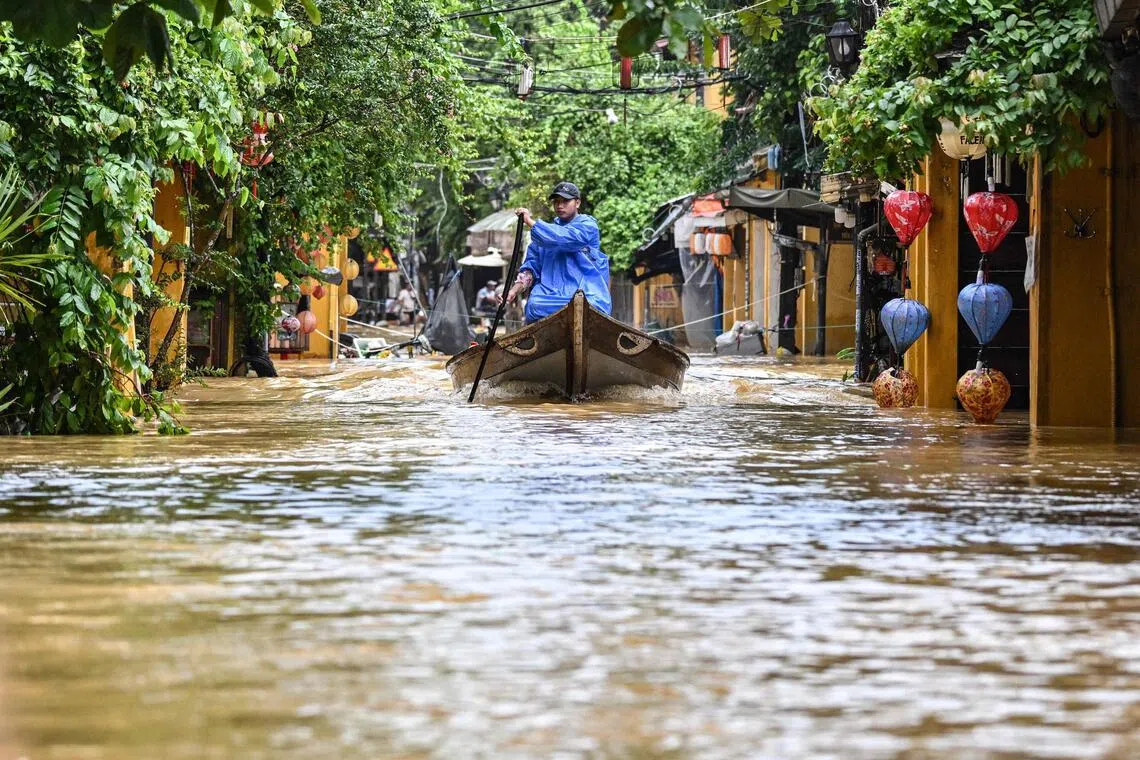Climate change, poor planning drive Vietnam flooding
Sign up now: Get insights on Asia's fast-moving developments

A man navigates a flooded street on a boat following heavy rains in Hoi An, on Oct 30, 2025.
PHOTO: AFP
Follow topic:
Hanoi - Dozens of people dead, thousands evacuated and millions of dollars in damage. Vietnam is once again battling widespread flooding driven by climate change and poor infrastructure decisions, experts say.
The South-east Asian nation’s location and topography make it naturally vulnerable to frequent typhoons and some flooding, but the situation is being made worse by the heavier rainfall that climate change brings and rampant urbanisation.
Stronger, wetter storms
Vietnam is in one of the most active tropical cyclone regions on earth and is prone to heavy rain between June and September.
Ten typhoons or tropical storms usually affect the country, directly or offshore, in a given year, but it has experienced 12 already in 2025.
“Climate change is already shaping Vietnam’s exposure in several important ways,” said Dr Phuong Loan Nguyen, a climate scientist at the University of New South Wales.
Studies suggest climate change will produce fewer but “possibly more intense tropical cyclones (typhoons)” along with heavier bursts of rain because a warmer atmosphere holds more moisture.
“That means a higher chance of flash floods, especially in densely populated urban areas,” said Dr Nguyen.
Rising sea levels are also putting pressure on coastal communities.
Topography, infrastructure
With 3,200km of coastline and a network of 2,300 rivers, Vietnam faces a high risk of flooding.
Much of the country has little natural ability to drain quickly after heavy flooding because of its topography, hydrological experts said.
In some cases, construction and environmental degradation has made matters worse, said meteorological expert Nguyen Lan Oanh.
Upstream forest destruction for hydropower projects, cementing of drainage canals and rampant urbanisation have “badly contributed to the source of flooding and increased landslides”, she told AFP.
“Humans need to change their perception in the way they treat nature for a safer world.”
Devastating impacts
This week alone, floods triggered by record rainfall in central Vietnam have killed at least 10 people and inundated more than 100,000 homes.
In the coastal city of Hue, up to 1.7m of rain fell in just 24 hours.
The flooding follows several rounds of inundations in the capital Hanoi and elsewhere, linked to storm systems or heavy rain fronts.
Natural disasters – mostly storms, floods and landslides – left 187 people dead or missing in Vietnam in the first nine months of 2025.
Hundreds more were killed or left missing in 2024, many due to Typhoon Yagi, the strongest storm to hit Vietnam in decades. Yagi caused an estimated US$1.6 billion (S$2.1 billion) in economic losses.
Responses
Vietnam “is making great efforts at (improving) early warning”, said Dr Ralf Toumi, director of the Grantham Institute – Climate Change and the Environment at Imperial College London.
In recent flood incidents, the government has issued evacuation orders and assisted residents in moving to higher ground.
But “the infrastructure also needs to be continuously improved as the country is getting richer”, Dr Toumi added.
Dykes, sea barriers and drainage systems in major deltas on the Red River and the Mekong have been reinforced, upgraded or newly built.
And after deadly landslides and flash floods triggered by Yagi, part of an entire village in northern Lao Cai province was relocated to safer, higher ground.
However, Dr Brad Jessup, an environmental expert at the University of Melbourne, said that often “the focus is on disaster infrastructure, whereas it should also be on not creating disaster risk”.
“Without attending to risk reduction, the need for protection infrastructure keeps on increasing. It is a spiral.”
Climate adaptation is expensive, and wealthy countries have consistently failed to keep promises on climate funding for developing nations like Vietnam.
Rich countries pledged in 2021 to double their adaptation financing by 2025, but instead, the figure has fallen, the UN said this week. AFP

